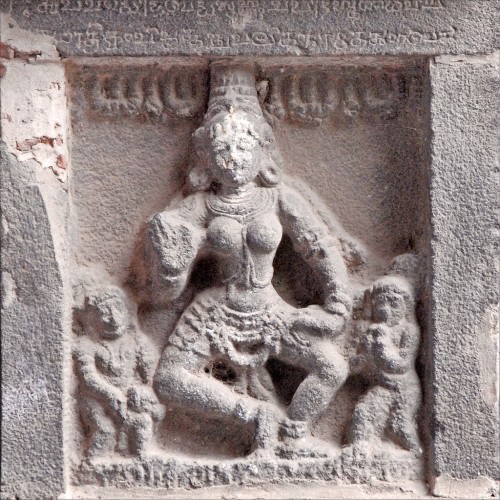Chichen Itza › Chidambaram › Silla Pottery » Origins and History
Articles and Definitions › Contents
- Chichen Itza › Origins
- Chidambaram › Origins
- Silla Pottery › Origins
Ancient civilizations › Historical places, and their characters
Chichen Itza › Origins
Definition and Origins
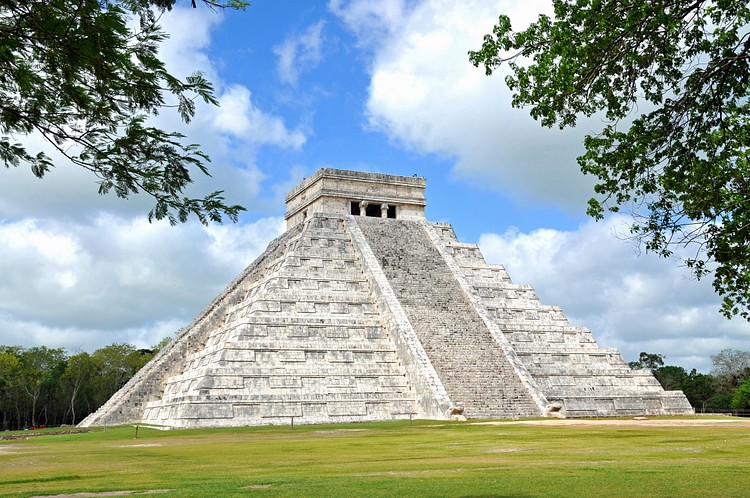
Chichen Itza, located at the northern tip of the Yucatán Peninsula of modern Mexico, was a Maya city which was later significantly influenced by the Toltec civilization. Flourishing between c. 750 and 1200 CE, the site is rich in monumental architecture and sculpture which promote themes of militarism and displays imagery of jaguars, eagles, and feathered-serpents. Probably a capital city ruling over a confederacy of neighbouring states, Chichen Itza was one of the great Mesoamerican cities and remains today one of the most popular tourist sites in Mexico.
HISTORICAL OVERVIEW
The name Chichen Itza probably derives from a large sinkhole known as the Sacred Cenote or 'mouth of the well of the Itza' into which the Maya threw offerings of jade and gold, and as the presence of bones testifies, human sacrifices. The early history of the site is still not clear, but settlement was certain by the Classic period (c. 250-900 CE). With the collapse of Teotihuacan, migrants may have come to the site from varying parts of Mesoamerica, and it seems likely there was contact with the Itza, a Maya group. A second period of construction seems to coincide with influence from the Toltec civilization.That Chichen Itza was a thriving trade centre with a port at Isla Cerritos is evidenced by finds of goods from elsewhere in Central America, for example, turquoise from the north, gold disks from the south, and obsidian from the Isthmus of Tehuantepec. The cultivation of cacao is known, and the city may have controlled the lucrative salt beds on the nearby northern coast.
DOMINATING CHICHEN ITZA IS THE HUGE PYRAMID OF KUKULCAN, ALSO KNOWN AS THE CASTILLO.
The city has been traditionally divided into two distinct parts and periods, even if there is some overlap both in time and design, and together they cover some 16 square kilometres. The earliest, in the south, is native Maya dating to the Epiclassic period (c. 800-1000 CE) with buildings displaying the distinct 'Puuc' architectural style and Maya hieroglyphs. The plan is more spread out than other parts of the city and, constructed on a roughly north-south axis, may reflect the course of the Xtoloc Cenote water source.
The second part of the city has been traditionally dated to 1000-1200 CE and is more mysterious, creating one of the most contentious debates in Mesoamerican archaeology. Built in the Florescent style and along a more ordered plan, it displays many hallmarks of the Toltec civilization, leading scholars to believe that they either conquered Chichen Itza as they expanded their empire from their capital Tula over 1,000 km away, or there was some sort of cultural and trade sharing between the two centres. Common features between the two cities found in architecture and relief sculpture include warrior columns, quetzal-feathered rattlesnakes, the clothing of subjects, chacmools (sacrificial basins in the form of a reclining person), atlantides (support columns in the form of standing males), the representation of certain animals, a tzompantli (sacrificial skull rack), Tlaloc (the rain god) incense burners, and personal names represented by glyphs which are present at both sites but which are not Maya.
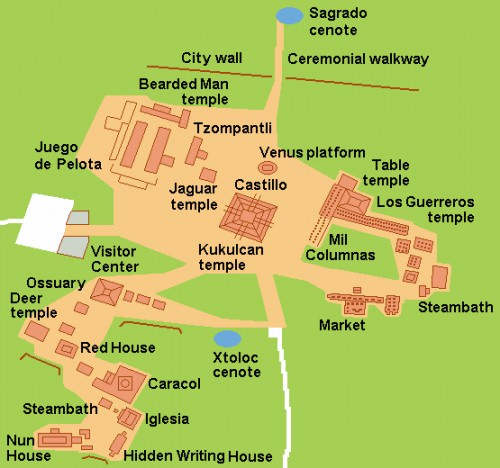
Map of Chichen Itza
Alternative to the two-period view, the Americas historian George Kubler divides the buildings of Chichen Itza into three distinct phases: prior to 800 CE, from 800 to 1050 CE, and 1050-1200 CE. Kubler adds that the latter stage saw the addition of ornate narrative reliefs to many of the buildings at the site. It has also been suggested that due to various styles of architecture pre-dating those found at the Toltec capital Tula, it may actually have been Chichen Itza which influenced the Toltec rather than the reverse. The exact relationship between the two cultures has yet to be ascertained for certain, and there are certainly other Mesoamerican (but non-Toltec) architectural and artistic features at Chichen Itza which are evidence of an influence from other sites such as Xochicalco and El Tajin.
Chichen Itza fell into a rapid decline from 1200 CE, and Mayapán became the new capital. However, unlike many other sites, Chichen Itza never disappeared from memory, and the city continued to be revered and esteemed as a place of ancestry and pilgrimage into the Postclassic period and up to the Spanish conquest, and even beyond.
ARCHITECTURAL HIGHLIGHTS
The earlier section of Chichen Itza displays many Classic Maya traits. The Temple of the Three Lintels, for example, has Chahk masks at each corner. Other structures include two small temples built on raised platforms, known as the Red House and the House of the Deer, and a pyramid known as the High Priest's Grave, named after the discovery of a tomb within it.There is also the 7th century CE Red House with its bloodletting frieze, the Nunnery with its carvings of the rain god Chac, and the small temple known as the Iglesia. All are Classic period structures.
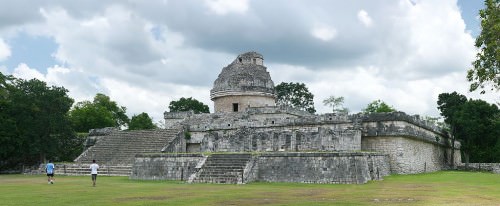
The Caracol, Chichen Itza
THE CARACOL
The Caracol is one of the most impressive monuments at the site. It was constructed prior to 800 CE and was used as an astronomical observatory, especially of Venus, and perhaps was also a temple to Kukulcan in his guise as the god of the winds. A large flight of stairs on two levels leads to the circular tower structure which has windows not aligned with the steps giving the illusion the tower is turning. The interior vaulting may have been designed to represent a conch shell (an object associated with Kukulcan), and a spiral staircase gives access to the second floor. The vault is over 10 m high, the largest such Maya structure. The building as it is seen today was probably a result of remodelling to incorporate Toltec design features.
PYRAMID OF KUKULCAN
Dominating Chichen Itza is the huge Pyramid of Kukulcan, also known as the Castillo (Castle), constructed before 1050 CE.The pyramid is 24 metres high, each side is 58-9 metres wide, and it has nine levels. On each side of the pyramid is a staircase which leads up to a single modest square structure. This summit building has two chambers and is decorated with jaguar relief panels and round shields. Each stairway climbing the pyramid has 91steps, except the northern side which has 92, and so, adding all four together, one arrives at a significant 365. Seen from above, the cross created by the stairways imposed on top of the square pyramid base recalls the Maya sign for zero. At certain times of year, for example on the autumnal equinox, triangular shadows from the different levels of the pyramid are cast onto the sides of the northern staircase, giving the illusion a gigantic snake is climbing the structure built in honour of the feathered-serpent god. The northern side also has large stone snake heads to further remind the purpose of the building. Used for religious ceremonies, human sacrifices would also have been made on the top terrace. Inside the pyramid another 9-level pyramid was built, this one with only a single staircase on the north side. Inside were a chacmool and a red jaguar throne inlaid with jade. This smaller pyramid was probably used for a royal burial, perhaps even of the great Toltec king Topiltzin Quetzalcoatl.
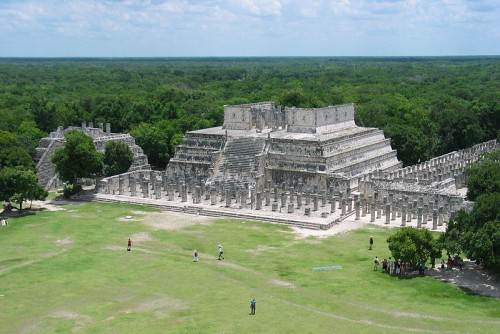
Temple of the Warriors, Chichen Itza
TEMPLE OF THE WARRIORS
Another huge structure at Chichen Itza is the Temple of the Warriors, a three-level pyramid with neighbouring colonnades on two sides creating a semi-enclosed court. It was built in the Early Post-Classic period, sometime between 800 and 1050 CE.The colonnade of carved warrior and female gift bearer columns in front of the pyramid would have once had a roof. The building at the top of the pyramid has a doorway framed with feathered-serpents and two chambers; one contained a chacmool and the other a throne. The structure shares many common features with the Toltec Pyramid B of Tula. Buried within the base of the temple is another, older structure known as the Temple of the Chacmool. The interior walls of the temple were decorated with wall paintings showing scenes of warriors with captives, a lake, and thatched houses, all with some attempt made at achieving perspective. Next to the Temple of the Warriors is a more ruined pyramid known as the Mercado which has a 36- column gallery in front of it, and a small ballcourt.
GREAT BALLCOURT
The Great Ballcourt of Chichen Itza, measuring 146 mx 36 m, is the largest in Mesoamerica. It was constructed between 1050 and 1200 CE and is also unusual in that the sides of the court are vertical and not sloped as in most other courts. Temple platforms close off each end of the court. The lower parts of the walls and the ring on each wall are decorated with carvings of snakes. The dimensions of the court are so grand that it is difficult to envisage actual games being played here. The rings, for example, through which players had to direct the solid rubber ball, are placed at a height of 8 m. The relief carvings on the walls of the court remind us of the ritual function of ball games; for example, there is a gruesome scene of two seven-man teams facing each other and one team captain decapitating the losing captain of the opposition. It is a scene repeated on all six relief panels along the two benches of the ballcourt.
TZOMPANTLI
Near the great ballcourt a large platform takes the form of a skull rack or tzompantli, and a second platform, the Platform of the Eagles, has relief carvings depicting jaguars and eagles eating human hearts. Both were built 1050-1200 CE, and they are further indicators that human sacrifice was a part of religious ceremonies at Chichen Itza.
Chidambaram › Origins
Silla Pottery › Origins
Ancient Civilizations
The pottery of ancient Korea stretches back to prehistory when simple brown wares were made and decorated with geometrical incisions and ends with the production of the superb celadons and white porcelain of the Goryeo dynasty but between these periods the Silla kingdom produced distinctive stoneware and pottery of its own. Whilst it is true that the majority of pottery from this period is strictly functional and was largely placed in tombs as mere containers for goods the deceased would require in the afterlife, there are also purely artistic creations, especially anthropomorphic spouted vessels which represent animals and people. These latter pieces employ a wide range of potter's techniques, and besides their aesthetic value, they have also provided historians with valuable insights into facets of daily life in ancient Silla from armour to architecture.
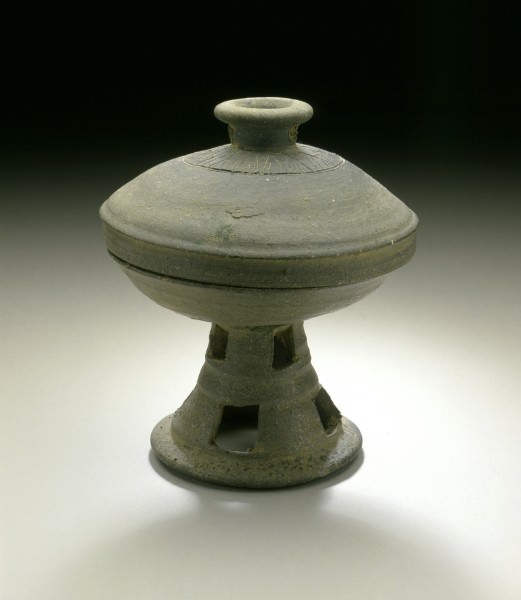
Silla Kobae Bowl Stand
Korean ceramics produced after the Silla kingdom would become much sought-after in contemporary east Asia and subsequently the wider world, but it may be said that, splendid though these later pieces may be, they reflect a significant influence from Chinese ceramics. The pottery of the Silla period, in contrast, is markedly more 'Korean,' as the art historian Chewon Kim states,
Silla pottery may well be the most genuinely indigenous of all Korean art forms, in spite of the formal influences from outside which were brought to bear upon it. It varies from the near-primitive to the sophisticated, but it invariably has about it a natural quality which bespeaks its specifically Korean origin. (53)
SILLA KINGDOM (57 BCE - 668 CE)
Kilns
High-fired grey stoneware was produced by the Silla kingdom and the contemporary Baekje and Gaya states, too. Stoneware requires a high firing temperature (800°-1000° C), and this technology was, no doubt, connected to the furnaces required to produce iron in the Gaya confederation which was rich in that metal. Gaya potters likely received the technology from Chinavia the northern commanderies such as Lelang and then passed on this innovation to their Korean neighbours and even Japan. The most common kiln type in Silla was the 'tunnel' or 'climbing' kiln, so-called because they were built into hillsides.They could be 20 metres long and 5 metres wide with shelving cut into the interior of the slope to stand pottery on and a chimney shaft dug to rise up the inside of the slope. There is no evidence of deliberate glazing in this period, although there are examples where accidental ash dropping from the kiln roof onto the pot did create a primitive glaze.
PERHAPS THE MOST IMPRESSIVE SILLA POTTERY OBJECTS ARE THE TWO FIGURINE EWERS (TOU) IN THE FORM OF HORSE RIDERS.
Forms
Typical Silla stoneware forms are the stemmed cup, short-necked bulbous jars, long-necked jars ( changgyong ho ) and kobaebowls with wide stands. Kobae were probably influenced by the Chinese dou and are typically between 25 and 35 cm tall. The lid with a small pedestal handle could be set upside down and serve as an extra dish. They were used on special occasions for food, not liquids. Examples of foodstuffs they contained when found in tombs include soybean paste, red pepper paste, kimchi(a seasoned vegetable dish), and fermented fish sauce. The long-necked jars were used to carry water, and their high neck reduced spillage. The base is either slightly rounded or indented, which aided their transport, traditionally on a small cushion placed on the carrier's head. Some jars have a foot attached, while those without would have been supported by a stand when not in use.
Other pottery shapes include horned cups, cups with wheels attached, one-handled cups, large bulbous jars with short necks (sometimes with pierced stands too), and bell cups which have small pieces of clay inside a hollow lower section so that they rattle when lifted. Miniature ceramic animal figures include rabbits, dogs, cows, pigs, tigers, tortoise, snakes, ducks, and one elephant (the latter is poorly rendered suggesting the potter had no model or personal experience to draw on). Most such figures come from the tombs at Hwangnamni, Gyeongju. Perhaps the most impressive pottery objects are the figurine ewers ( tou ) in the form of armoured horse riders, boats with a single oarsman, a two-wheeled chariot, and even temples and houses with thatched roofs. They were meant to pour rice wine or water during religious ceremonies and were placed in tombs to accompany the deceased into the next life.

Silla Ceramic Warrior
Two of the finest examples of such figures were discovered in the Golden Bell Tomb at Gyeongju in 1924 CE. Both are horsemen (with the rider and horse being independent pieces), but one is a servant and the other is a warrior with details of costume and horse trappings rendered in applied clay pieces. The warrior or master figure is slightly larger at 25 cm tall and 29.5 cm long, no doubt also indicating his superior rank to his fellow. He wears an aristocratic peaked hat and short sword while his horse has a decorated saddle and bridle. The figures were so placed in the tomb that the servant was leading his master, as it were, into the next life. On both figures, the spout is on the chest of the horse and the funnel for filling the vessel is behind the rider. More rudimentary human figures have also been found in tombs. Male figures often have a simple cylindrical body, phallus, open or folded arms and appear to be singing suggesting they were fertility symbols.
Pottery stands ( kurut pachim ) were produced in the Baekje kingdom and the Gaya confederation, but they became something of a speciality in the Silla kingdom of the 5th and 6th century CE. Two varieties were manufactured: the first is a mere stand topped by a concave rim in which a bowl could be placed, while the second type has a bowl integrated into its top.Both types are more angular in profile than other Korean versions. Decoration takes the form of horizontal bands or cut-out rows of triangle and rectangle holes. Besides being used for serving food during meals, the large size of some of the stands suggests they might have been used in religious ceremonies.

Silla Ceramic Oil Lamp
Finally, ceramic lamps of the period most often take the form of a series of cups arranged around a larger central cup. Imitating metal lamps, the oil could pass through a channel connecting the base of each cup. Some examples have suspended leaf shapes as an extra decoration.
Decoration
Ceramics were decorated with incisions of geometric forms, especially circles, semi-circles, parallel and wavy lines, and V-shapes. Sometimes additional clay pieces, including three-dimensional figures, were added or portions of the clay were cut away to create a latticework effect. Added figures often reveal the daily life of the Silla kingdom and include copulating couples, musicians playing the zither ( kayagum ), and one with an A-frame ( chige ) to support carried goods on his back.Amongst other added three-dimensional decorations are leaves and snakes illustrating the importance of Shamanism in ancient Korea's religious practices. The suspended leaf decoration is reminiscent of Silla metalwork, especially gold crowns and earrings. Drawings of figures are rare, but there are some examples of simple human and animal forms incised onto vessels.
UNIFIED SILLA KINGDOM (668-935 CE)
As the Three Kingdoms period gave way to the Unified Silla period where Silla gained control of the Korean peninsula, pottery began to display a marked influence from Buddhism. Cremation necessitated the manufacture of urns for ashes, and Buddhist motifs prevail as stamped decoration such as lotus buds for lid handles, lotus flowers, and clouds. Another Unified Silla use of ceramics was floor and roof tiles. The former have floral designs, especially honeysuckle and lotus flowers, while the latter can have fierce mask designs to ward off evil spirits. Roof tiles have been found in great numbers and are of two types: a semicircular form closed by a decorative disk at one end or a flatter version with a decorated edge. Both types were made using moulds, typically of clay and more rarely of wood.

Funerary Urn, Unified Silla Kingdom
As in the previous period, human and animal figures were produced, but these are now more sophisticated and attempt to capture details such as clothing – notably baggy trousers and long-sleeved tunics. Dancers, officials, soldiers, servants, and even bearded individuals were made which suggests contact with western Asians, probably via Tang dynasty China.
Everyday pottery was generally left undecorated, but special pieces, when they are decorated, show a greater density of designs than previously, now achieved by the use of stamps rather than by hand. There is, too, the first appearance of a deliberate ash glaze in the 8th century CE which, although rudimentary, would develop into the later celadon ceramics of the subsequent Goryeo period which would match the finest wares produced in China or anywhere else.
This article was made possible with generous support from the British Korean Society.
LICENSE
Article based on information obtained from these sources:with permission from the Website Ancient History Encyclopedia
Content is available under License Creative Commons: Attribution-NonCommercial-ShareAlike 3.0 Unported. CC-BY-NC-SA License

